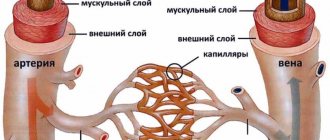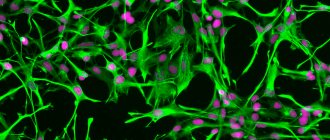Causes of cortical dysarthria in children
The defect develops as a result of damage to those areas of the cerebral cortex that regulate the tone and contractions of the muscles of the cheek, pharynx, jaw, soft palate, lips and tongue.
The cause of the disorder may be:
- perinatal pathology is the main cause of brain damage in childhood. Hypoxia, intrauterine infection, and asphyxia of the newborn are important. The likelihood of these conditions is increased by a complicated obstetric history, oligohydramnios, gestosis, and rapid labor;
- traumatic brain injuries - in children, birth injuries play an important role, which occur due to inadequately chosen labor management tactics. Injuries at an early age are dangerous due to falls and impacts. Brain damage in older children and adolescents can also cause speech disorders;
- space-occupying formations lead to compression of the cerebral cortex, sometimes to germination and destruction, that is, destruction;
- neuroinfections - consequences of ARVI, rubella, herpes, measles, sinusitis, sinusitis, otitis, abscess, syphilis, tuberculosis.
The mechanism of development of the cortical form of dysarthria is associated with damage to the anterior central gyrus or the area behind it. In the first case, central paresis of the articulatory muscles develops. In the second, the processing of information about the state of the organs of articulation is disrupted, which is why there is no correction of the movements of the muscles involved in speech. This is how apraxia occurs - a failure in the sequence of muscle contractions.
Causes pathologists
The factors that provoke the development of pathological pronunciation disorders are varied. The characteristics of cortical dysarthria indicate several causes of its occurrence.
- Unfavorable intrauterine development of the fetus due to hypoxia and intrauterine infection.
- Postpartum asphyxia in a child.
- Traumatic brain injury (TBI) caused by difficult childbirth or blows or contusions to the head during infancy.
- Neoplasm in the cerebral cortex.
- Consequences of infectious diseases, including rubella, influenza, herpes, otitis media, tuberculosis, ARVI.
The causes of cortical dysarthria in children are often associated with rapid premature birth. The possibility of developing the disease in adults cannot be ruled out. The most common cause in this category of patients is stroke.
Classification of cortical dysarthria in children
Depending on the location of the pathological focus and the mechanism of development, two types of pathology are distinguished:
- Cortical kinetic dysarthria (efferent) is associated with damage to the central zone of the anterior cortex. Due to the proximity of the area that controls hand movements, hemiparesis may occur. Characterized by slowness of speech and lack of rhythm. Some children speak in syllables;
- Kinesthetic (afferent) dysarthria is associated with damage to the postcentral zones. It is characterized by discoordinated work of the organs of articulation and movements of the muscles of the hand on the opposite side.
Based on severity, there are 4 forms of the defect. In the first degree there is no clear clinical picture, then their severity increases. Grade 4 may be accompanied by complete anarthria, that is, lack of speech.
Mixed variants of the disease are possible, for example, cortical-subcortical dysarthria, when in addition to the cortical part, the subcortical parts of the brain are also affected.
Classification
The symptoms of the disease directly depend on the type of disease. With efferent - cortical kinetic dysarthria, accompanied by damage to the anterior zone of the cerebral cortex, a slow speech rate and lack of rhythm are observed. Sometimes such patients pronounce words syllable by syllable.
The afferent (kinesthetic) form provokes pathological changes in the lower left lobe of the cerebral hemisphere. In this case, the child reproduces articulation, but does it with effort. It is difficult for him to pronounce consonants and hissing sounds.
Depending on the severity, there are 4 degrees of pathology. Phase I of cortical dysarthria is weakly expressed. Lack of treatment provokes an increase in symptoms. In form IV, complete absence of speech is possible.
Symptoms of cortical dysarthria in children
Characteristic symptoms of cortical dysarthria are disturbances in the tempo-rhythmic component of speech: there is a slow pace of expressive speech, lack of fluency and automatism. From the outside it seems that it is difficult for the child to move his tongue and lips.
The most difficult sounds are the anterior lingual sounds. The baby replaces or skips problematic sounds. Because of this, speech is blurred and slurred. But there are no problems with the semantic part, that is, the vocabulary is sufficient, children correctly use words in sentences and correctly express their thoughts.
Cortical-subcortical dysarthria is characterized by violent involuntary movements at rest and during conversation.
Afferent cortical dysarthria
Signs of this variant of cortical dysarthria are the search for the correct articulatory structure when pronouncing sounds, which causes pauses. The voice, due to stress during conversation, is loud with a decrease in voiced consonants. Due to the slowness of speech, intercalary sounds appear.
The baby pronounces affricates (consonants made of two sounds) separately or pronounces only a separate part. For example, “t” or “s” or the prolonged “ts” from instead of the sound “ts”. It also replaces some sounds with others: fricative consonants with stop consonants. The child cannot name the place on the face that the speech therapist touches.
Efferent cortical dysarthria
Cortical kinetic dysarthria is characterized by slowness of speech due to problematic transitions between sounds. Stressed vowels are lengthened, and consonants, if they are at the beginning and end of a word, too. The pronunciation of “l”, “sh”, “r”, “zh” suffers: this requires the participation of the tongue, and the child’s tongue movements are difficult. He can replace them with “d” or “t”.
It is difficult for a child to fix the desired articulatory position, so there are unnecessary insertions and omissions of sounds. Children may wrinkle their forehead, stick out their tongue, close their eyes, and lick their lips when talking.
EEG analysis and psychophysiological interpretation of bioelectrical activity of the brain
From the earliest period of development of the EEG method, the diagnostic task was to find correlates between the characteristics of mental activity disorders and the bioelectric picture of the brain. Epileptology is much luckier in this regard than psychiatry. Graphically, discharge activity patterns have been studied, described, and are widely used in everyday practice. It was not possible to find similar elements on the EEG that would convincingly indicate the fact of a particular mental disorder. This is not to say that there was no success at all. Many authors have noted that, for example, a high mu rhythm1 or a slow equivalent of the mu rhythm in the theta range2, as a rule, accompany the clinical picture of neurotic disorders, but these signs have not received general recognition.
Most attempts to connect mental characteristics and EEG patterns were aimed primarily at searching for their connection with frequency characteristics in a particular range. An attempt to work in the direction of studying the frequency dependence on the type of psychiatric pathology, apparently, was a consequence of the methodological transfer of successes in the diagnosis of focal lesions in tumors, vascular malformations, and brain injuries, where a fairly definite connection was traced between EEG wave parameters and local destruction of brain tissue.
Every research deserves respect, but not every one leads to the expected result, especially if the search goes in the wrong direction. And he seemed to be going in the wrong direction. Optimistic bursts of information in individual reports that it had finally been possible to “establish” that such and such a mental illness is characterized by the predominance of certain wave features or their certain ratios, crashed against the rock of the nonspecificity of these features, since they were encountered and in other nosological forms.
For example, classical manuals on EEG often contain separate chapters describing changes in the bioelectrical activity of the brain in tumors, vascular disorders, infectious diseases, traumatic brain injury, etc. If you try to find significant differences in the characteristics of cortical rhythms in these conditions, you will find that it is difficult to do. Moreover, if you “accidentally” rearrange the table of contents from one chapter to another, the reader will not notice it. Everywhere there will be the same increase in the severity of slow waves and a weakening of the role of the main rhythm. This indicates the nonspecificity of the analyzed changes in frequency characteristics on the EEG in these pathological conditions. The connection will be traced only with the general condition of the patient, more precisely with the degree of preservation or impairment of the level of consciousness. In other words, any change in cortical rhythm is associated with the functional state of the brain.
Functional state of the brain
A trivial question arises: what is the functional state of the brain? And how can it be assessed based on EEG data? Oddly enough, this formulation of the question takes both practical and scientific users of this method by surprise and is accompanied by vague reasoning, although there are many publications using such a promising phrase.
Despite all the apparent obviousness of the concept of the functional state of the brain, in reality, not everything is so simple. The manuals on electroencephalography say in black and white that there are two functional states : sleep and wakefulness. However, when studying the biocurrents of the brain in a non-sleeping person, a certain concept of changes in the functional state of the brain is implied within the framework of wakefulness. For a long time there were no direct indications of what is meant by the functional state of the brain when examining a sick person who is formally fully conscious. Only in recent years has there been an attempt to formulate some positions of this definition3.
So what, then, is hidden under the mysterious concept of “functional state of the brain”?
In reality there is no mystery here. The guidelines correctly state that EEG assesses two functional states: sleep and wakefulness. Only the interpretation of wakefulness in EEG practice (not in neurophysiology in general!) was perceived as some kind of frozen stationary state. This perception of the concept of wakefulness significantly hampered the development of clinical nonepileptic electroencephalography. The level of wakefulness is not uniform. He is sometimes higher, sometimes lower. Such drift in the level of wakefulness can be either a completely physiological or an abnormal pathological manifestation.
It is a well-known fact that at a certain stage even recognized authorities in the field of electroencephalography (it is not correct to mention them by name) were very puzzled by the fact that the EEG changes under the influence of pharmacological agents. What then can we say about the rest? The well-established idea of the stability of the level of wakefulness naturally assumed a stable picture on the EEG, well, unless the subject fell asleep at the time of the study. In such cases, it was naturally understood that this was a different functional state, and therefore the EEG changed.
From the above it follows that the search for changes in the EEG pattern depending on the mental status of both healthy and sick people should be sought not in specific phenomena, not in frequency characteristics, but in the pattern of signs of an altered state of the level of wakefulness, precisely this component of the functional state of the brain . And this is quite accessible for such a method as EEG.
Cortical rhythm on EEG
Variants of the pattern of cortical rhythms on the EEG are determined by fluctuations in the balance of ascending activating and inhibitory influences, and during wakefulness the projection zone of these influences is not necessarily generalized, but may have spatial selectivity. In fact, variants of such anomalous regulation of the activity of neural ensembles determine precisely the “mysterious” functional state of the brain that can be studied by EEG. And this altered functional state is nothing more than variants of regional unevenness in the level of wakefulness. Even L.P. Latash (1968) drew attention to the fact that the process of falling asleep (read: decreasing the level of wakefulness) according to the EEG picture in different parts does not occur simultaneously.
A comparison of the EEG stages of shallow sleep with the state of clinical wakefulness of a person showed that they have a similar picture4 with the difference that in the first case the depth of sleep is diagnosed, and in the second - as God pleases, namely, they are interpreted as variants of “impaired functional state brain". If we accept the concept that the functional state of the brain is an altered state of the level of wakefulness, then such manifestations on the EEG as weakening and slowing of the alpha rhythm, episodes of its spatial distribution, an increase in the role of non-rough slow activity, its spatial synchronization, low theta - easily fit into this. flashes and so on. Moreover, in the model of children with attention deficit hyperactivity disorder or borderline mental disorders5, the chaos of frequency components of the EEG no longer seems meaningless, but acquires a specific qualitative characteristic, including easily explainable regional predominance of one or another rhythm. Regional inhibition (decrease in the level of wakefulness) can be interpreted as the appearance of local slow waves during tumor processes67, vascular and liquorodynamic disorders8, traumatic injuries, and so on.
Level of wakefulness
The level of wakefulness is inextricably linked with the main functional activity of the brain - the thought process. The content of thoughts from the EEG, as Penfield once dreamed about it, naturally cannot be read, but, as the experience of psychophysiologists9101112 and individual studies in clinical electroencephalography show, it is possible to establish the dominant nature of thoughts based on the peculiarities of the formation of bioelectrical activity of the brain, which is very important and promising in the diagnosis of panic disorders and other various forms of neuroses131415.
The overwhelming number of patients burdened with abnormal thoughts first of all turn to a neurologist, who is less interested in the characteristics of their mental status and more interested in the symptoms of their profile. As a rule, these patients are classified as patients with vegetative-vascular dystonia. An attempt to relate EEG changes to symptoms within this diagnosis was unsuccessful. Polymorphic clinical symptoms - a polymorphic picture of brain biocurrents. These same patients, when they get to a psychiatrist, are sorted according to symptoms corresponding to the characteristics of their mental status, according to the nature of the direction of thoughts. Comparison of the electroencephalographic picture in accordance with these criteria revealed a surprising pattern. Certain changes in the EEG began to follow the characteristic features of altered thinking in “orderly rows”1617.
The electroencephalographic picture is directly related to the nature of the thought process and, above all, to its level18.
First level of wakefulness
The first level is adaptive thinking of an extroverted orientation of analysis. It is focused primarily on operational analysis of current information from the external environment. This includes afferent signals from all sensory organs, as well as amounts of intellectual level information. This level of thinking is integral to the efferent response system when necessary. This level of thinking corresponds to a high level of wakefulness, and on an EEG recorded from a healthy person in a calm state with his eyes closed, a typical picture is recorded, which is described as a normal EEG with a modulated alpha rhythm in the occipital, an uncertain rhythm in the central and a desynchronized low beta rhythm in the frontal regions.
Second level of wakefulness
The second level is the process of spontaneous, involuntary thoughts flowing, regardless of the person’s will. Their content is not much different from the content of dreams. Current afferent information is not involved in the formation of parallel thoughts of the second level. The physiological aspect of this level is most likely the formation and preservation of long-term memory. This passive process has neither a goal nor objectives, interferes with concentration, and interferes with the operational processing of afferent signals. The second level corresponds to varying degrees of decreased wakefulness. The EEG picture (with eyes closed) at this level is more motley and is similar to the early stages of superficial sleep in the form of a predominance of diffuse low-amplitude uncertain slow rhythm with a weakening of the alpha rhythm in the posterior regions. It depends on the direction of thoughts. For example, anxious thoughts are accompanied by the prevalence, and even generalization, of the alpha rhythm, as a result of inappropriate concentration on them. For intense thoughts (without anxiety), the presence of low-voltage dysrhythmia on the EEG with a diffuse increase in the severity of low beta activity is more typical. What these visually dissimilar EEG events have in common is the entroverted direction of analysis.
Third level of wakefulness
The third level is also an introverted version of thinking associated with the regulation of the state of internal organs. As thinking, it is not recognized within the framework of a normally functioning healthy organism and takes on specific features only when there is an anomaly in a person’s mental status. This type of thinking is characteristic of somatoform and hypochondriacal disorders and corresponds to a reduced level of wakefulness. The electroencephalographic picture at this level of thinking is also quite motley and ambiguous, which is associated with different mechanisms of formation of the types of this pathological condition.
Electroencephalogram analysis
If we base the analysis of the electroencephalogram on the above positions on the interpretation of levels of wakefulness and the thought process, then completely different requirements must be made for the analysis of the EEG. For example, on the alpha rhythm model, we will no longer be satisfied with the traditional Berger definition of the International Association of Neurophysiologists, that this is a rhythm within the range of 8-13 Hz in the occipital regions, which fades away with visual activation. Its spatial preferential topography and the identification of not a single alpha rhythm, but many alpha rhythms19 come to the fore.
The rhythms of this range do not fit into Berger’s interpretation during the so-called alpha coma, which both functionally and topographically have a completely different origin, which is confirmed by the high level of coherent connections not in the posterior, but in the anterior and central parts of the cortex20.
Uncertain rhythm
Similar trends occur in the assessment of slow rhythms. From the perspective of interpreting the EEG as a drift in the level of wakefulness, the unpopular characteristic of “uncertain rhythmicity”21, a chaotic mixture of low-amplitude theta, alpha, low-frequency beta oscillations or spatially synchronized low (up to 40-60 µV) slow waves, often in theta, acquires significant meaning. range, which in no way fit the characteristics of flashes, but represent well-defined groups lasting from 1 to 4-5 s. A critical attitude has emerged towards the indispensable pathological significance of the very fact of the presence of bursts of the theta rhythm, with the obligatory conclusion about “dysfunction of the stem level”.
Low amplitude EEG
Despite the fairly high occurrence of electroencephalograms in the form of a low, uncertain rhythm in all areas with smoothed regional differences, their clinical interpretation remains to be improved. The term "low amplitude EEG" has always been vague. The point of view is being imposed that “low-amplitude recordings categorically belong to normal EEG variants”22, which is categorically, to put it mildly, controversial. It is known that low-voltage EEGs occur both in comatose patients and in fully conscious people declared healthy on the basis that they walk on their own legs and the patient's complaints, if any, go beyond the scope of neurological concepts.
Visually similar variants of low-amplitude EEG, when examined in detail, are not so identical.
Uncertain rhythm (low-amplitude theta, alpha and beta oscillations), which represents a low-voltage EEG, although externally similar, can be organized in different ways.
Low-voltage dysrhythmia
Already visual analysis makes it possible to establish different frequency composition in low-voltage dysrhythmia. We can distinguish a variant with an indefinite rhythm, where the predominance of low theta and alpha activity in the range of 30-40 μV with a low representation of beta waves comes to the fore, and a second option, when a diffusely desynchronized beta rhythm of 20-20 is superimposed on the slow, indefinite rhythm. 40 µV.
The first variant of slow low-voltage rhythm indicates a decrease in the level of wakefulness. It also visually resembles the initial stages of shallow sleep. The second option, fast, is more difficult to understand. On the one hand, one can accept the interpretation given by L.P. Latash that this state of super-wakefulness is the result of diffuse excitation throughout the cortex due to the predominance of ascending activating influences, on the other hand, many questions arise, since in some cases this is, of course, a sign of mobilization level of consciousness, in others - rapid low-voltage dysrhythmia, which also occurs with an obvious clinical weakening of concentration, that is, against the background of a reduced level of wakefulness.
The introduction of coherence analysis methods into practice drew our attention to the fact that low-voltage EEG has varying degrees of spatial synchronization. There are options with low or high levels of spatial connectivity.
Most often we have to deal with low-voltage EEGs, which are visually considered at the first presentation as a variant of “low-voltage dysrhythmia”, but with a high level of spatial synchronization according to coherence analysis in a wide frequency range. Visually assessing low-amplitude EEG from the perspective of the functional state of the brain without clinical information about the patient’s real condition is difficult and sometimes impossible. To some extent, assessing the level of potential synchronization (according to coherence analysis data) can come to the rescue. It has been established that with a deep level of loss of consciousness in the case of a coma with a depth of 4-6 points (according to the GLASGOW classification), interhemispheric interaction is disrupted and the values of average coherence (according to our recommendation 1-16 Hz) in transverse pairs drop below 0.2, and in preterminal states - up to hundredths and thousandths 232425.
If, in comatose states, dysrhythmic low-amplitude activity is caused by a violation of the relationship between the activities of neural ensembles and reflects the “chaos” of their residual bioelectrical activity, then in other types of low-voltage EEG in patients with intact consciousness, it is caused by a single mechanism for organizing cortical rhythms: the predominance of ascending activating (desynchronizing) influences above the ascending inhibitory (synchronizing) ones.
Organization and regulation of the level of wakefulness
The organization and regulation of the drift of the level of wakefulness and the formation of the thought process have a complex multifunctional and multistructural mechanism, the reflection of the activity of which at this stage of the development of neurophysiology can be formulated fragmentarily. First of all, this is a well-known mechanism of competitive interaction of ascending activating and inhibitory influences on the cerebral cortex, which can be fairly assessed by frequency-amplitude dominance on the electroencephalogram.
Rice. 1. Scheme of regulation of ascending inhibitory and activating influences of the hypothalamus by descending control of the prefrontal cortex
It is known that the trigger for the release of ascending activating influences is the suppression of the activity of ascending somnogenic influences, which are initially in a dominant state. Suppression of the activity of these hypothalamic structures is carried out by activation of descending influences from the prefrontal cortex (Fig. 1).
The role of the prefrontal cortex in brain activity has been increasingly debated in recent years. In fact, everything depends on its interaction with other cerebral parts: sleep, wakefulness, attention, memory, direction of thinking, assessment and regulation of the activity of internal organs. This is a command analytical “point” for constructing a forecast and organizing behavior.
It is possible to assess the state of activity of this part of the cortical convexity electroencephalographically using conventional means of EEG analysis (visually or based on power spectra data) very approximately. Simply establishing the frequency composition of the EEG in the frontal part of the brain for this purpose is not very informative. Mechanisms are needed to assess the relationship between the prefrontal cortex and other parts of the brain. Such analytical tools today are coherence analysis and the method of three-dimensional dispersion mapping of frequency and spatial dispersion of the alpha rhythm. The use of these methods made it possible to introduce such functional evaluation criteria of brain activity based on EEG data as hypofrontality and hyperfrontality, that is, to assess the degree and type of anomaly in intracerebral organization.
Literary sources
- Aleksandrov M.V., Ivanov L.B., Lytaev S.A. [etc.]. Electroencephalography: manual / ed. M. V. Alexandrova. — 3rd ed., revised. and additional - St. Petersburg: SpetsLit, 2021. - 224 p.
- Aleksandrov M.V., Ivanov L.B., Lytaev S.A. [etc.]. General electroencephalography / ed. M. V. Alexandrova. - St. Petersburg: Strategy of the Future, 2021. - 128 p.
- Brezhe M. Electrical activity of the nervous system: trans. from English - M.: Mir, 1979. - 264 p.
- Dokukina T.V., Misyuk N.N. Visual and computer EEG in clinical practice. - Minsk: Kshgazbor, 2011. - 112 p.
- Zenkov L. R. Clinical epileptology (with elements of neurophysiology). – M.: MIA, 2002. – 416 p.
- Zenkov L. R., Ronkin M. A. Functional diagnosis of nervous diseases: a guide for doctors. - M.: MEDpress-inform, 2010. - 488 p.
- Lytaev S. A., Aleksandrov M. V., Berezantseva M. S. Psychophysiology. - St. Petersburg: SpetsLit, 2021. – 256 p.
- Rusinov V. S., Mayorgik V. E., Grindel O. M. [et al.]. Clinical electroencephalography / ed. V. S. Rusinova. - M.: Medicine, 1973. - 339 p.
- Niedermeyer E., Lopes da Silwa F. Electroencephalography. Basis, principles, clinical applications related fields. - Philadelphia-Baltimore - NY: Lippincott Williams & Wilkins, 2005. - 1309 p.
Footnotes
- Evtushenko S.K., Omelyanenko A.A. Clinical electroencephalography in children: a guide. - Donetsk: Donetsk region, 2005.
- Iznak. F., Nikishova M. B. Electrophysiological correlates of psychogenic disorders // Human Physiology. - 2007. - No. 2. - P. 137-139.
- Ivanov L. B. Non-epileptic electroencephalography. - M.: MBN, 2013.
- Ivanov L. B. Non-epileptic electroencephalography. - M.: MBN, 2013.
- Iznak A.F., Nikishova M.B. Electrophysiological correlates of psychogenic disorders //Human Physiology. - 2007. - No. 2. - P. 137-139
- Boldyreva G. N. Electroencephalographic activity of the human brain with damage to diencephalic and limbic structures. - M.: Nauka, 2000.
- Mayorgik V. E. Clinical electrocorticography. - M.: Medicine, 1964.
- Sirbiladze G. K., Svyatogor I. A., Guseva N. L., Yuryeva R. G. The use of computer electroencephalography to assess the state of cerebrospinal fluid dynamics: abstracts of the scientific and practical conference “Clinical Neurophysiology”. St. Petersburg, November 19, 2013 - pp. 140-141.
- Ivanitsky A. M., Podkletova I. M. Taratynova G. M. Study of the dynamics of intracortical interaction in the process of mental activity // Journal. higher, nervous activities - 1990. - T. 40, No. 2. - P. 230-237.
- Ivanitsky G. A. Recognition of the type of problem being solved in the mind from a few seconds of EEG using a trained classifier // Zh. higher, nervous activities - 1997. - T. 47, No. 4. - P. 743-747.
- Ivanitsky A. M. Informational synthesis in crucial cortical area as the brain base of subjective experience. In Miller R., Ivanitsky A., Balaban P. (Eds.), Complex Brain Functions: Conceptual Advances in Russian Neuroscience. - Harwood Academic Publishers: Reading, UK, 1999. -P.173-196.
- Tarasova I.V., Wolf N.V., Razumnikova O.M. Changes in EEG coherence when performing an imaginative creative task in men and women // Bulletin of the Siberian Branch of the Russian Academy of Medical Sciences. – 2007. – No. 1 (123).
- Ivanov L. B., Strekalina N. N., Chulkova N. Yu., Budkevig A. V. Variants of spatial distribution of alpha activity depending on the form of affective disorders // Functional diagnostics. - 2009. - No. 1. - P. 41-50.
- Strekalina N. N., Chulkova N. Yu., Ivanov L. B. Spatial distribution of alpha activity depending on the form of affective disorder: materials of the All-Russian conference. - FGU MNIIP. Russian Society of Psychiatrists. Moscow, October 28-30, 2008 - pp. 381-382.
- Chulkova N. Yu., Strekalina N. N., Ivanov L. B. Using spectral coherence analysis to assess the effectiveness of therapy for affective disorders: materials of the All-Russian conference. - FGU MNIIP. Russian Society of Psychiatrists. Moscow October 28-30, 2008 - pp. 388-389.
- Melnikova T. S., Lapin I. A., Yurkin M. M. Mitrofanov A. A., Krasnov V. N., Kryukov V. V. Dynamics of coherent relationships at different stages of the formation of psychoorganic syndrome // Functional diagnostics. - 2009. - No. 1. - P. 36-41.
- Misyuk N. N., Dakukina T. V. EEG mapping in identifying signs of organic brain damage in patients with mental illnesses // Journal of Neurology and Psychiatry named after. S. S. Korsakova. - 2000. - No. 5. - P. 39-44.
- Ivanov L. B. Non-epileptic electroencephalography. - M.: MBN, 2013.
- Ivanov L. B. Applied computer electroencephalography. - M.: MBN, 2004.
- Aleksandrov M.V., Arutyunyan A.V., Vasiliev S.A., Aleksandrova T.V. Prognostic value of patterns with rhythmic alpha activity in exotoxic coma // Vestnik VMedA. — 2013. — 3.
- Latash L.P. Hypothalamus, adaptive activity and electroencephalogram. - M.: Nauka, 1968.
- Evtushenko S.K., Omelyanenko A.A. Clinical electroencephalography in children: a guide. - Donetsk: Donetsk region, 2005.
- Ermolaeva T. P., Ivanov L. B., Selezneva Zh. V., Shchedrinskaya S. Yu. Analysis of interhemispheric connections to predict the outcome of long-term comatose states of traumatic and hypoxic origin in children using coherent EEG analysis: materials of the all-Russian conference. - FGU MNIIP. Russian Society of Psychiatrists. Moscow October 28-30, 2008 – pp. 368-369.
- Ivanov L. B. On the informativeness of the use of coherence analysis in clinical electroencephalography // Higher nervous activity. - 2011. - T. 61, No. 4. - P. 499-512.
- Ivanov L. B. Applied computer electroencephalography. - M.: MBN, 2004.
Complications in children
Speech defects affect the development of speech in general, the state of the nervous system and cognitive functions. Children do not develop their vocabulary well, and they have a general underdevelopment of speech. Attention and memory deteriorate. A pronunciation defect causes a deterioration in the perception of phonemes. Such violations are fraught with learning problems: written speech and reading suffer.
At older ages, the likelihood of psychological problems is high. School-age children have a hard time with speech disorders, become withdrawn, and may show aggression and irritability. Depression may develop. The situation becomes more complicated if there is a lack of understanding and help from parents.
Diagnosis of cortical dysarthria in children
The diagnosis is made based on an examination by a neurologist, speech therapist and the results of instrumental research methods:
- A neurological examination can reveal paresis of facial and articulatory muscles, facial asymmetry, and deviation of the tongue to one side. Difficulties in performing sequential actions at the request of a doctor are also identified;
- The speech therapist identifies not only the symptoms of cortical dysarthria, but also its characteristics and causes. Determines the degree of disturbance, the presence of its components: replacement of sounds, slowness and unevenness of speech;
- Hardware research methods make it possible to evaluate the structure of the brain and identify pathological foci: space-occupying formations, hematomas, consequences of traumatic brain injuries. Depending on the situation, an MRI or CT scan may be prescribed;
- Lumbar puncture is performed if a neuroinfection is suspected. This method allows you to evaluate the properties and amount of cerebrospinal fluid and identify the pathogen.
If necessary, the patient can be examined by other specialists. For example, in case of extensive education - an oncologist and neurosurgeon, in case of neuroinfection - an infectious disease specialist, a phthisiatrician.
Diagnosis and treatment
It is difficult to diagnose the cortical form of dysarthria in a child under 2 years of age. The type of speech pathology is determined by a neurologist and speech therapist. The following types of examinations are carried out: neuroimaging, CT and MRI of the brain, PET-CT, lumbar puncture.
Based on the examination results, the doctor prescribes treatment.
Correction of the cortical form of dysarthria involves a set of measures that normalize speech function. Depending on the characteristics of the clinical course of the pathology, in particular, the following methods are used: the use of nootropic, vascular-strengthening and sedative medications; articulation exercises; correction of the pronunciation of difficult to pronounce sounds; breathing exercises; classes on developing expressive speech; finger training; speech therapy massage.
To eliminate speech disorders, the doctor prescribes additional procedures. This includes acupressure, therapeutic exercises, and physiotherapy sessions.
Treatment of cortical dysarthria in children
Correction of cortical dysarthria begins with pathogenetic treatment of the disease that led to a speech defect. Without this step, no amount of speech therapy help will help restore speech.
Complex treatment includes:
- drug therapy aimed at stimulating metabolism in the brain and restoring its functions. Prescribe nootropic drugs, vitamins, metabolites. In difficult cases, sedatives, tranquilizers, and antidepressants may be needed;
- speech therapy correction of cortical dysarthria - speech therapy massage, articulation gymnastics, development of fine motor skills of the hands, production of sounds. If necessary, a psychologist is involved in the treatment process;
- physiotherapeutic procedures, reflexology, massage, physical therapy help eliminate muscle paresis and improve blood flow throughout the body;
- Relaxation techniques - art therapy, aromatherapy, music therapy help relieve stress and improve the emotional background.
Conventional treatment is long-term. Specialists prescribe several courses of therapy, during which they can adjust the program taking into account the body’s response to therapeutic measures.
Prognosis and prevention
Timely initiation of therapy using a comprehensive individual approach and the absence of complex neurological pathology are the main conditions for complete speech restoration. The child overcomes his speech impediment and in the future leads a normal life typical for his age. He can study in a regular school and successfully master the school curriculum.
If cerebral palsy or another neurological disease is present, or there is a space-occupying lesion, the prognosis is difficult. In any case, with a competent approach, it is possible to improve speech and reduce the severity of the defect.
Prevention of the cortical form of dysarthria consists of planning pregnancy, giving up bad habits during pregnancy, timely treatment of emerging problems, and preventing complications of pregnancy and childbirth. It is important to choose a method of delivery in advance to prevent birth injuries.










